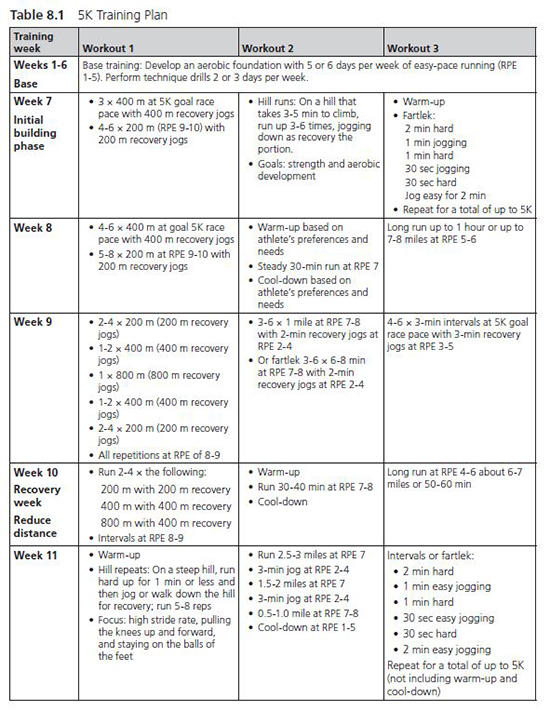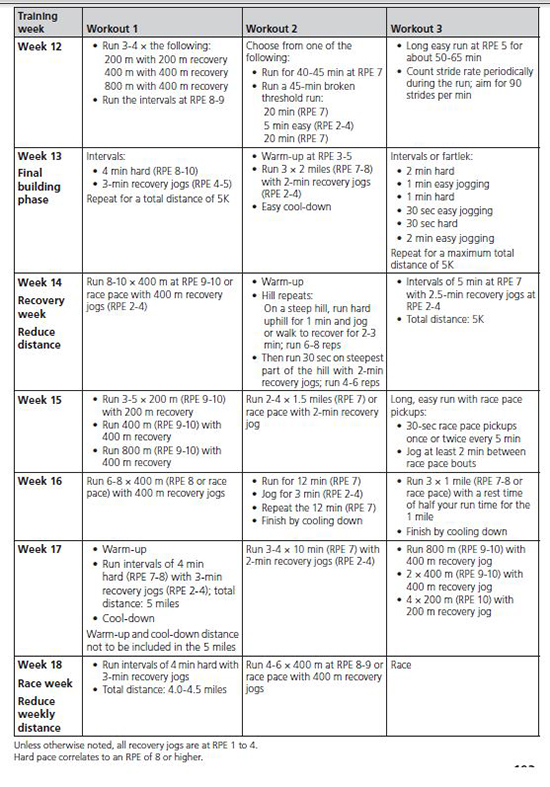Sample 5K Training Plan for Runners
by Developing Endurance
Kinetic Select
May 2017
This excerpt from the book Developing Endurance, published by Human Kinetics, presents a sample 5K training plan for runners.
The following is an exclusive excerpt from the book Developing Endurance, published by Human Kinetics. All text and images provided by Human Kinetics.

5K Training Plan
The first 6 weeks of training for a 5K should be dedicated to base training (Table 8.1). In the first 3 weeks, athletes should run at least 4 days per week at an easy pace (RPE 1 to 5) for about 30 minutes each session. The program could include more or less depending on the athlete’s running experience. Cardiovascular cross-training—such as swimming, cycling, or pool running—should be incorporated 2 or 3 days per week to supplement the remaining days. In addition, strength training can be done up to 4 days per week along with aerobic training.
For the final 3 weeks of base training, running should increase to 5 or 6 days per week, and technique development drills should be incorporated into three training sessions each week. One session each week should be a long run, which is a low-intensity run of longer distance than any other run in the week (the long run should not be more than 25 percent of the total weekly distance). The athlete continues strength training and decreases cross-training to 1 or 2 days. One day each week should be used for active recovery or cross-training.
Weeks 7 to 12 are considered the first building phase, which means that training intensity should increase; the training will now include 2 or 3 days of hard workouts. The focus should be on increasing foot speed and aerobic capacity using threshold and interval running. Total distance will increase during this period, but not more than 10 percent every 3 weeks. Recovery is also very important during this period; easy runs and passive recovery techniques should be emphasized. In addition to the high-intensity workouts, easy runs should be included in the schedule.
Alternative forms of aerobic exercise may substitute for easy running on recovery days. Swimming, water running, cross-country skiing, and cycling are great alternatives because they relieve the joints of stress while maintaining cardiovascular demands. For the last 5 weeks of training (weeks 13 to 18), the intensity should be increased slightly by emphasizing running at threshold pace and using intervals of longer duration. For most recreational athletes racing the 5K distance, the taper for competition is built into the training program. The 2 days before race day are used for recovery runs.
As part of the recovery runs, technique drills should be used as a means for activating the fast-twitch muscle fibers without causing fatigue.


From the National Strength and Conditioning Association (NSCA) comes this resource packed with more than 100 drills to help in the development of agility and quickness training programs. Applicable to almost every sport, Developing Agility and Quickness focuses on improving athletes’ fleetness of foot, change-of-direction speed, and reaction time. The book is available in bookstores everywhere, as well as online in the NSCA Store.
Coaches
Program design
5k training plan couch to 5k 5k training program how to run a 5k Suzie Snyder sprint training 5k for beginners
- Privacy Policy
- Your Privacy Choices
- Terms of Use
- Retraction and Correction Policy
- © 2025 National Strength and Conditioning Association